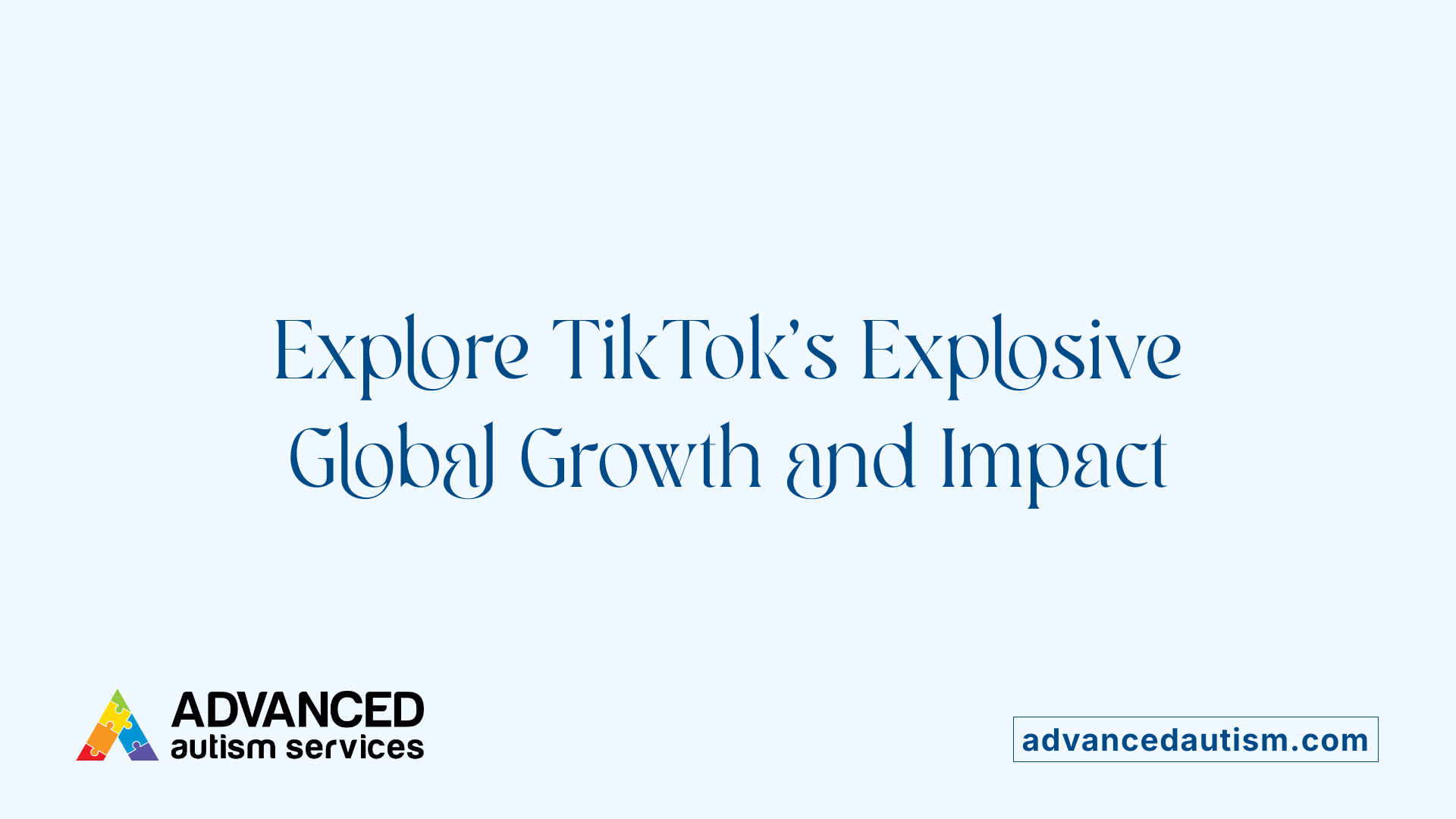Understanding TikTok’s Explosive Rise and Demographics
Since its launch in 2016, TikTok has experienced unprecedented growth, transforming from a niche app into a global social media powerhouse. Its rapid expansion has been driven by unique content formats, a highly engaged young audience, and innovative marketing strategies. This article explores the essential facts, statistics, and demographic insights that define TikTok’s influence in the modern digital landscape.
TikTok’s Remarkable Global Reach and User Base Growth

What are some key facts and statistics about TikTok?
TikTok has experienced explosive growth since its launch, amassing over 1.59 billion monthly active users worldwide as of 2025. This makes it one of the most popular social media platforms globally, especially among younger demographics. The platform has been downloaded more than 4.1 billion times, establishing itself as a leading entertainment and content-sharing app.
Daily activity on TikTok is staggering—users upload around 1 million videos daily, reflecting a high level of user engagement. On average, users spend about 58 minutes each day on the app. This intense engagement has contributed significantly to TikTok’s rise in industry revenue, which surged from approximately $63 million in 2017 to an estimated $23.6 billion in 2024.
Total monthly active users
By 2025, TikTok’s global user count has grown tremendously, with estimates placing around 1.6 billion monthly active users. The United States alone accounts for over 150 million users, making it a prime market for brands and advertisers.
Download and usage statistics
The platform’s popularity is reflected in its download numbers, reaching over 4 billion worldwide. In Q2 2025, TikTok's global downloads hit 192 million, while daily interactions exceed 1 billion views of videos. Users open the app around 20 times per day, often spending nearly an hour each session.
Platform growth timeline
TikTok’s journey began in September 2016, initially under the name Musical.ly before rebranding after its acquisition by ByteDance in 2017. It rapidly grew in popularity, especially during and after the COVID-19 pandemic, hitting milestones such as 1 billion active users in September 2021. It continued expanding yearly, reaching 1.58 billion monthly active users in April 2024 and surpassing 1.6 billion by 2025.
Overall, TikTok’s trajectory showcases persistent growth, driven by high user engagement, frequent content creation, and expanding global influence. Its evolution from a niche entertainment app to a dominant social media giant highlights its significance in digital culture and marketing.
| Metric | Statistic | Additional Details |
|---|---|---|
| Monthly active users | 1.6 billion (2025) | Including global estimates and key markets |
| Total downloads | Over 4.1 billion | Downloaded worldwide since launch |
| Daily uploaded videos | 1 million | Content creation remains prolific |
| User engagement | 58 minutes/day | Average time spent per user |
| Revenue | $23.6 billion (2024) | Industry impact and growth |
| Peak growth milestone | 1 billion users in September 2021 | Rapid expansion during pandemic |
This data underscores TikTok’s position as a dominant social media platform, with substantial influence on global entertainment, marketing, and digital trends.
Demographic Composition: Age and Gender Breakdown
What is the demographic breakdown of TikTok users by gender and age?
TikTok's user base is predominantly young, reflecting its appeal among the digital-savvy generation. As of July 2025, more than half of the global users—55%—are under 30 years old. Specifically, the age group of 18-24 years accounts for approximately 27.2% of US users, though this has decreased from 35% in 2022, indicating growing diversity in age demographics.
The most active content creators are primarily youth, with the 18-24 age group representing over half (52.83%) of TikTok creators worldwide. This youthful vigor helps drive the platform's vibrant trend culture.
Regarding gender distribution, TikTok has a slightly male-leaning demographic, with 53.3% of users being male as of July 2025. Females comprise about 46.5%, showing a fairly balanced gender split.
In the United States, the largest segment remains the 25-34 age range, which makes up around 39.7% of the platform's user population, reflecting broader engagement from early adults.
This demographic composition influences content trends, marketing strategies, and platform features tailored to young and diverse audiences.
Additional insights into user demographics
| Demographic Aspect | Percentage or Data Point | Additional Details |
|---|---|---|
| Age group 18-24 | 27.2% US users, decreased from 35% in 2022 | Indicates diversification in age |
| Users under 25 | Over 55% of global users | Major active segment |
| Active content creators | 52.83% aged 18-24 | High youth participation |
| Gender distribution | 53.3% male, 46.5% female | Slight male majority |
| Largest US demographic | 25-34 years | 39.7% of users |
This demographic snapshot highlights TikTok’s core popularity among youth and early adults, shaping the platform's cultural and marketing dynamics.
Regional and Global User Distribution

Overall Age Distribution of TikTok Users
Globally, TikTok’s user base is predominantly composed of young adults. About 55% of users are under 30 years old, indicating the platform's strong appeal among younger demographics. This trend is consistent across most key markets.
Key Countries and Regions
The largest population of users resides in Indonesia, with over 157 million active TikTok account holders as of April 2024. The United States follows closely, with more than 121 million users, making it the biggest single national market broadly. Other significant countries include Brazil, with approximately 99 million users, and Mexico, Vietnam, Russia, Pakistan, the Philippines, Thailand, and Turkey, each contributing substantial portions to the global user pool.
Percentage of Visits from Different Regions
In terms of platform engagement, the United States accounts for about 24% of all TikTok visits worldwide, reflecting its high user activity. Asia-Pacific, the Middle East, and Africa combined host over half of TikTok’s monthly active users, with over 50% of users coming from these regions. Specifically, Indonesia alone accounts for a large share of usage, with about 157.6 million active users in 2024.
Regional Usage Patterns
Usage patterns vary significantly across regions. In Finland, users spend the most time on TikTok—averaging nearly 55 hours per month. In contrast, countries like Nigeria exhibit high saturation with over 87% of internet users aged 16+ having used TikTok in the past month. In the US, younger adults (ages 18-24) and those aged 25-34 are the most active, with those under 25 constituting about a quarter of the traffic.
Overall, TikTok’s growth continues to be driven by high engagement in Asia, especially Indonesia, and increasing adoption among young adults in Western countries. Its widespread use across diverse age groups and regions underscores its global influence and the platform’s ability to cater to varied cultural preferences.
Usage Patterns and Engagement Metrics
What are TikTok’s usage and engagement patterns?
TikTok is one of the most active social media platforms globally, with more than 1.58 billion monthly users as of 2024. Users are highly engaged, especially in regions like the United States, where average daily usage exceeds 26 hours per month. This translates to roughly 53.8 minutes spent on the app daily, illustrating the platform’s addictive appeal.
The frequency with which users access TikTok is remarkable — individuals open the app up to 20 times a day. Such repeated interactions highlight its role as a go-to source for entertainment, trends, and social connection.
Content interaction on TikTok is notably high. The average engagement rate per post hovers around 2.5%, which is substantially higher compared to other social media networks. On a typical day, over 1,120 interactions are recorded per video, with likes being the predominant form of engagement.
Additionally, users spend a significant amount of time consuming content—globally, they spend billions of minutes daily, with US users alone consuming about 4.8 billion minutes in 2024. The platform’s design encourages continuous scrolling and interaction through the personalized 'For You' page, which 85% of users find interesting.
The combination of frequent app openings, extensive daily usage, and high content interaction solidifies TikTok’s status as a central hub for entertainment and social interaction in the digital age.
Content Trends and Popularity Drivers
What are TikTok’s content and engagement patterns?
TikTok’s content ecosystem is characterized by its vibrancy and diversity, primarily driven by formats that resonate with its predominantly young user base. Viral challenges, dance routines, and Gen Z commentaries dominate the platform, making content highly engaging and shareable.
Popular TikTok hashtags like #FYP (For You Page), which has accumulated over 45 trillion views globally, play a crucial role in content virality. This hashtag spans countless trending videos, helping creators gain massive visibility.
Influencer presence significantly shapes platform dynamics. Top creators such as Khaby Lame, with over 162 million followers, and Charli D’Amelio, with billions of likes, exemplify how influential figures can elevate engagement levels. Brand collaborations with these influencers often lead to high interaction rates, making influencer marketing a vital part of TikTok's ecosystem.
The most-liked TikTok video to date is Bella Poarch’s lip sync to
Market Share and Industry Impact

What is TikTok’s market position and industry impact?
TikTok has established itself as a major force in the global social media landscape. As of 2024, the platform boasts over 2 billion active users worldwide, demonstrating its rapid growth and widespread appeal.
The platform's valuation soared past $110 billion in 2025, making it one of the most valuable social media companies. Its popularity is further reflected in its ranking as the fifth most-used social network globally and the second most downloaded app, with an impressive 773 million downloads in the first half of 2025 alone.
Advertising revenue is a significant part of TikTok’s economic influence. In 2024, the platform generated approximately $23.3 billion from ad sales, marking a substantial increase that underscores its effectiveness as a marketing channel. This rapid monetization highlights TikTok’s ability to attract brands keen to tap into its highly engaged user base.
TikTok’s short-video format, combined with high engagement rates—averaging around 4.64%—and active creator participation have revolutionized digital marketing strategies. Influencers and brands are leveraging TikTok’s unique environment to run viral campaigns, enhance product discovery, and foster social commerce.
Overall, TikTok's industry impact lies in transforming traditional advertising, influencing cultural trends, and reshaping how brands engage with consumers in the digital age.
User Perception and Behavioral Trends

What are TikTok user perception and behavior trends?
TikTok has established itself as a major platform not just for entertainment, but also for brand discovery and social commerce. Data shows that 61% of users find new brands through TikTok, emphasizing its importance for marketing and product promotion.
The influence of TikTok on purchasing decisions is significant. Approximately 78% of users have bought a product after watching a creator’s content, illustrating the platform’s power to drive real-world sales. This retail effect is further supported by the fact that around 55% of TikTok users are open to tolerating ads if it means free access to content, highlighting a generally receptive attitude towards advertising.
Content creation on TikTok is mostly driven by younger demographics, especially Millennials and Generation Z. They frequently participate in viral trends, challenges, and connect authentically with brands. Many creators, mainly under 35, leverage TikTok not only for sharing personal content but also for engaging with audiences and promoting products, often leading to direct purchases.
This active participation illustrates a shift in consumer behavior—users are not just passive viewers but active participants in brand conversations and commerce. The platform’s emphasis on trending content and user engagement continues to shape how consumers discover and buy products, making TikTok a crucial space for modern marketing strategies.
Influencer Marketing and Revenue Opportunities
How do influencer marketing and monetization work on TikTok?
TikTok has become a powerful platform for influencer marketing, offering significant earning potential for content creators. Top TikTok influencers can earn up to $5 million annually through brand collaborations, sponsored content, and the platform’s Creator Fund, which supports over a million creators worldwide.
Influencers typically charge around $10 per post for every 1,000 followers they have. For example, a creator with 100,000 followers might earn about $1,000 per sponsored post. However, small influencers, especially those with highly engaged audiences within niche markets, often achieve engagement rates as high as 18%, surpassing larger accounts.
Brands see TikTok’s authentic and relatable environment as an ideal space for their campaigns. They partner with influencers to promote products through creative videos, challenges, and trends, leveraging TikTok’s viral nature. These partnerships can significantly boost campaign effectiveness, with some reports indicating view-through rates increasing by nearly 200%.
Successful brand campaigns on TikTok often focus on emotional messaging and fast-paced, engaging content that resonates with younger audiences, especially Generation Z.
Through these collaborations, influencers and brands generate substantial revenue. TikTok’s emphasis on authentic content creation, combined with the platform’s viral sharing features, creates lucrative opportunities for influencers to monetize their creativity while helping brands reach targeted audiences effectively.
The Future Outlook for TikTok and Its Users

What is the future outlook for TikTok and its user base?
Projections suggest that TikTok will keep growing rapidly, with estimates indicating the platform will reach over 2.35 billion users by 2029. This growth will likely continue in existing markets like the US, Indonesia, and Brazil, as well as in emerging regions such as Africa and Southeast Asia.
The platform's user base is expected to diversify, attracting more older demographics alongside its traditional young audience. Current data shows a significant shift, with the 18-24 age group decreasing from 35% in 2022 to 27.2% in 2025, while users under 30 now account for 55%. By 2027, monthly active users in the US are forecasted to surpass 150 million, further cementing TikTok’s position as a dominant social media channel.
Emerging features such as TikTok Shop, live shopping, and advanced analytics are poised to become mainstream. These innovations will empower content creators, brands, and advertisers to engage users more effectively, leveraging native shopping experiences and real-time data insights.
As TikTok evolves, its influence on culture, marketing, and social trends will deepen. Its role as a digital trendsetter and marketing powerhouse is set to expand, making it an essential component of global digital life well into the next decade.
Harnessing TikTok’s Potential in the Digital Age
TikTok’s meteoric rise from a simple lip-sync app to a global digital giant underscores its importance in modern social media and marketing landscapes. With over 2 billion users and its influence spanning across industries, TikTok is redefining how brands reach audiences. Its demographic profile, high engagement levels, and innovative features make it a platform worth watching. As TikTok continues to grow and introduce new features, understanding its user base and leveraging its massive reach will be crucial for marketers, content creators, and consumers alike.
References
- TikTok User Age, Gender, & Demographics (2025) - Exploding Topics
- TikTok - statistics & facts - Statista
- 25 Essential TikTok Statistics You Need to Know in 2025
- 16 TikTok Facts and Statistics to Know in 2025 - yellowHEAD
- 28 TikTok statistics marketers need to know in 2025 - Sprout Social
- Top 23 TikTok Statistics & Facts you need to know in 2025!
- TikTok Statistics You Need to Know in 2025 - Backlinko



